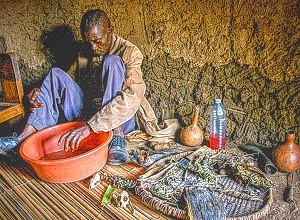Traditional healers trained to administer HIV testing and counselling to their patients significantly increased the proportion of patients receiving testing and linkage to care in rural Uganda.
In a cluster-randomised trial of 500 patients, 100% of those randomised to receive HIV counselling and testing from traditional healers consented to screening and were tested by their healer versus only 23% of those who were directed by their healer to go to a medical clinic for testing, reported Dr Radhika Sundararajan, of Weill Cornell Medicine in New York City.
Moreover, 10 participants in the intervention arm tested positive for HIV and seven of those were linked to care versus zero in the control arm.
During a presentation at the virtual Conference on Retroviruses and Opportunistic Infections (CROI 2021), Sundararajan noted that traditional healers are frequently preferred for medical care in sub-Saharan Africa, as they are considered more accessible than medical clinics.
Traditional healers do not usually discuss or offer HIV testing, but 80% of individuals in sub-Saharan Africa visit these healers in addition to or instead of medical clinics; 34% of adults in Uganda receiving care from traditional healers had not been tested for HIV in the last 12 months, contrary to the country's guidelines recommending all sexually active adults be tested annually.
"Some have proposed cooperating with traditional healers may be an avenue to increase uptake of HIV testing among populations who may be difficult to reach," Sundararajan said.
Her group performed a cluster-randomized trial in a rural region of Uganda with an HIV prevalence of 7.9%, higher than the national average of 5%. They trained all four traditional healer specialties — herbalists, spiritualists, birth attendants, and bone setters – in HIV counselling, including administering a point-of-care HIV test.
Healers were eligible if they were adults with a practice location within 8 km of the township and saw more than seven patients per week. Patients were eligible if they were sexually active adults with unknown HIV serostatus and no prior HIV diagnosis. The primary outcome was receiving an HIV test within 90 days of enrolment.
The intervention arm included healers who delivered HIV education and offered a point-of-care nasal swab HIV test, as well as pre- and post-test counselling; if patients tested positive, they provided linkage to care in a local clinic. The control group of healers was also trained in HIV education and advised patients to get an HIV test at a local clinic.
From August 2019 to February 2020, 17 healers and 500 patients were randomised to the intervention arm (nine healers, 250 patients) or to the control arm (8 healers, 250 patients).
The majority of healers were men, with a median age ranging from 40-47. Of the patients, about 42%-46% were men, with a median age of about 29-30. Nearly all had received an HIV test, but the majority hadn't been tested in 2 years or more.
There was a 4.4-fold increased likelihood of receiving an HIV test among those randomised to the intervention group compared with controls, with a difference in testing uptake rates of 77.2% (95% CI 72.8-81.6%). Specifically, only 57 of 250 control patients received an HIV test compared with all intervention patients.
[link url="https://www.medpagetoday.com/meetingcoverage/croi/91622?"]Full MedPage Today report (Open access)[/link]
[link url="https://www.croiconference.org/vcroi-2021/"]CROI 2021 study (abstract book)[/link]

